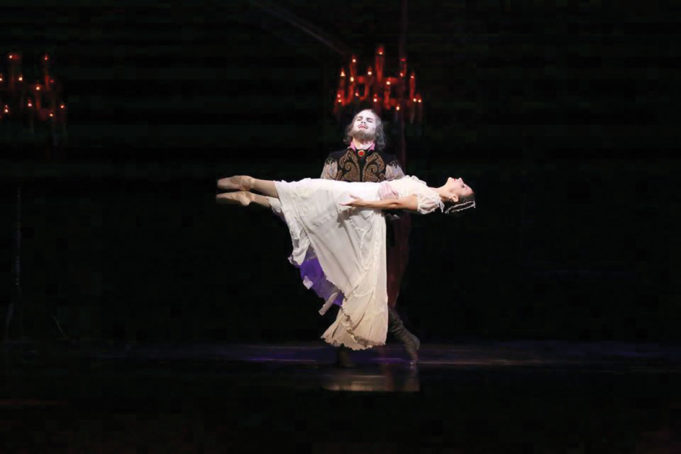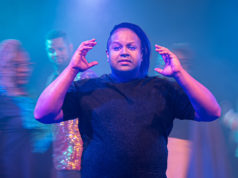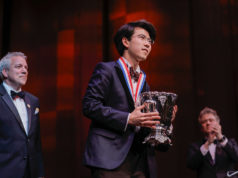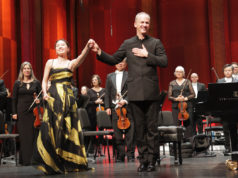In his 27 years leading the Houston Ballet, Ben Stevenson choreographed many full-length ballets, from Swan Lake to Don Quixote and beyond, including four of his own creations: The Snow Maiden, Peer Gynt, Cleopatra, and Dracula. Of the four, Dracula is probably the most popular, judging by sold-out Bass Performance Hall Saturday night. It was the third time the ballet has been presented here since he became artistic director of Texas Ballet Theater in 2003, and it really draws the crowds.
This was actually the Fort Worth premiere of a new production. In 2012, the Ballet Santiago of Chile got the O.K. to commission new sets and costumes identical to the original, underwritten by the Amon G. Carter Foundation. After performances there, Wells Fargo paid for shipping everything to Fort Worth along with performance costs here and in Dallas, a windfall for TBT, the new owner of the production. The show played in Dallas last month.
Stevenson created Dracula in 1997 to celebrate the 100th anniversary of Bram Stokers’ iconic horror novel. He worked closely with arranger John Lanchbery to find the right background music from the orchestral and piano music of Franz Liszt.
The ballet opened in the enormous, dimly lit crypt in Count Dracula’s castle, where he was just waking up. Slowly his 18 wives oozed onstage in white gowns with long filmy skirts, arms stretched in front, and the girls began a series of synchronized patterns that gradually increased in tempo to almost a frenzy. Two of the dancers were lifted overhead. Dracula, strongly danced by Carl Coomer, surveyed his harem in a huge, heavily decorated cape, made larger by hand held extensions as he swooped around the room. At one point he, too, flew straight up out of sight, returning later through a stage-level doorway.
The scene may have been a bit repetitious and a little long, but the second act was a jewel: a twilight party in the village square to celebrate the 18th birthday of Svetlana, the local inn keeper’s daughter, superbly danced by Leticia Oliveira. Festivities started with couples performing stylized folk dances. Then the women took over dancing their own sequences followed by the men, who performed with long staves, which they banged on the stage in time to the music and tossed to one another in carefree revelry. The ensemble work was excellent.
There were a touching few moments, too, when an elderly lady sitting on the sideline, played by Amanda Fairweather, was encouraged to join in. With her arms she slowly outlined the dances of her youth, and her face lit up. But age soon took over, and she hobbled back to her seat.
Svetlana, to make her birthday complete, convinced her father he should agree to her marrying her sweetheart Frederick, handsomely danced by Marlen Alimanov. For the young lovers, Stevenson created one of his most satisfying pas de deux. Many subtle nuances were visible in the gentle lifts and extended phrasing. Despite a slight stumble Oliveria was a joy to watch, and Alimanov was exceptional. His lifts looked effortless, and he was a strong partner. There were a few rough edges in his solo dancing, but his prolonged rapid turns with one leg extended 45 degrees reminded me of a young Baryshnikov.
As the dancing wound to an end, thunder crashed and a ruckus erupted. Dracula came charging onstage in a funereal-looking coach pulled by two dancers in horse costumes. As the coach swerved around, he and his helpers grabbed Svetlana and carried her off to his castle.
Act three found Svetlana being prepared for a wedding. But not to Frederick. After being brought to Dracula’s chambers, she did her best to resist him. And just as he was about to stick his teeth into her neck, Frederick appeared with the village priest, her father, and several other men. Mayhem broke out. The fight went back and forth until Frederick saved the day by pulling aside the huge draperies from the window, allowing in the sunlight. Dracula immediately flew up to a ceiling fixture for protection, but it was too late. The sunlight got him, and he was destroyed in a shower of sparks and the loudest blast I’ve ever heard in a theater.
TBT was lucky to have the Fort Worth Symphony Orchestra in the pit conducted by Michael Moricz. The sound was exceptional and the playing first class. Moricz has become an important part of the TBT experience in the short time he’s been here. Shields-Collins Bray played the extended piano solos with compelling lyricism and a husky sound where needed.
TBT’s next performances will be part of the annual Nutcracker series beginning December 11 in Bass Hall. For the first time in decades, TBT will not perform The Nutcracker in Dallas this year.












